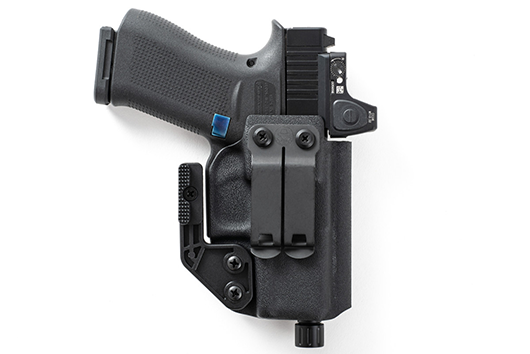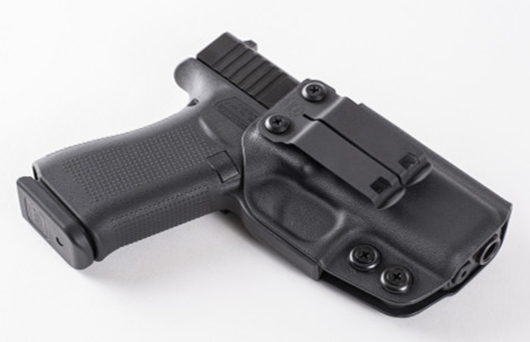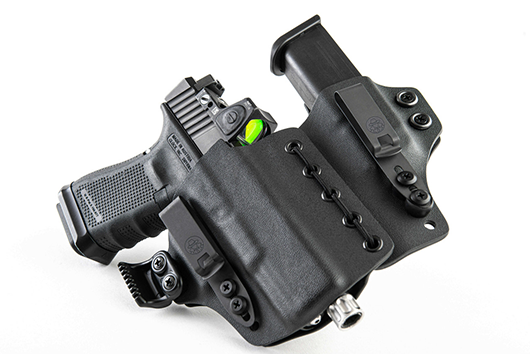How To Conceal Carry While Wearing Business Clothing
Aug 14th 2023
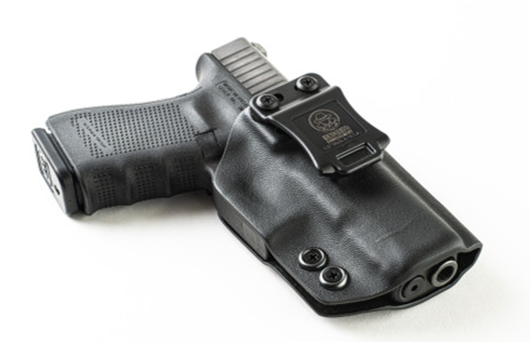
Most concealed carry advice assumes the gun owner is wearing casual, everyday attire that can accommodate a proper gun belt. However, many people with a formal dress code don’t find carrying a concealed firearm as easy or comfortable as in casual wear, so they give up on everyday carry.
Our recommendations allow you to conceal-carry your favorite handgun as easily as John Wick or James Bond while wearing business attire.
Choosing the Right Firearm
Whether you need to wear business attire for work, formal events, or simply out of personal preference, choosing the right firearm is one of the easiest ways to make your concealed carry setup work.
Generally, smaller, slimmer, lighter handguns, such as subcompact pistols or snub-nosed revolvers, present less of a profile than mid-sized or duty-sized handguns.
While you can adjust and make a larger or more powerful handgun work with business attire, this decision risks making your setup less comfortable or easy to carry. If you sacrifice too much, it risks becoming uncomfortable and reduces your ability to conceal-carry it every day.
If you don’t find it comfortable to carry your handgun daily and in every position or situation you might find yourself, consider selecting a smaller handgun.
Selecting a Carry Method for Businesswear
As with regular, casual outfits, the carry method determines the type of holster you’ll need. Finding the best concealed carry holsters for business attire depends on the types of clothing you wear, the size and weight of your handgun, and your personal preferences.
Carrying with a Tucked-in Formal Shirt, No Suit
Depending on the job, many professional settings require wearing traditional business clothes: a suit jacket, tucked-in formal shirt, tie, and dress pants for men and women. Unless your dress code or circumstances require you to keep the jacket on, you’ll likely be in situations with just a formal shirt and a tie covering your upper body. This is especially true during the warmer months or in climate-controlled office environments.
If you intend to conceal-carry with a formal shirt as your cover garment, you may have already noticed it is more form-fitting than a casual shirt. This is why carrying in business wear is more challenging, even if you have dress pants and a suitable gun belt. A formal shirt tucked into your pants makes you more likely to print.
Fortunately, there are some methods to help you overcome the challenges of conceal-carrying in a formal shirt, including:
Select a Slim IWB Holster
When wearing a formal shirt as your only cover garment, minimizing the risk of printing becomes a priority. The best solution is to wear a discreet gun belt and a slim, low-profile inside-the-waistband (IWB) holster.
Slim holsters are purpose-designed to provide your firearm’s proper retention and orientation with the minimum amount of material necessary. In addition to being slimmer and printing less than standard holsters, they are also lighter, reducing sagging on your gun belt.
Adjust Your Carry Position Accordingly
You can work around your shirt’s form-fitting properties by selecting a suitable carry position for your IWB holster. The traditional position is strong-side hip carry, placing your holster in the 3-o’clock position (right hip) if you’re right-handed or the 9-o’clock position (left hip) if left-handed. While it is the most natural carry position, it can also print the most due to the gun’s position being on the extremity of your hip.
Alternative carry positions you can try with a formal shirt include appendix carry and behind-the-hip carry.
- Appendix carry places your gun in or around the 12-o’clock position, prints much less than other carry positions, and makes the draw stroke more natural. For most shooters, pulling a formal shirt and reaching for a gun from the front of your body is easier and quicker than from the side or behind a hip.
However, safely carrying appendix requires a dedicated appendix IWB (AIWB) holster and discipline. A holstered gun in an AIWB holster will also point directly at your crotch or femoral artery, requiring an extremely disciplined hand to avoid an accident.
- Behind-the-hip carry means your holster is behind the hip, corresponding to your dominant hand. If you are right-handed, it will be at 4- or 5-o’clock. If you are left-handed, it will be between 7- and 8-o’clock.
Behind-the-hip carry is the basis of FBI carry, which combines this carry position with a specific cant angle. It allows you to retain similar draw strokes as traditional strong-side carry and use your hip and the sides of your body to better conceal your gun, even in a formal shirt.
However, the draw stroke will be longer, particularly from a relatively tight shirt, requiring dedicated practice to draw quickly.
Don’t hesitate to experiment with carry positions and your shirts and cover garments. Replicate the positions you will most likely adopt during the day at work and check whether your holster prints. Consider asking a friend to observe you and check whether they can tell if you’re armed.
Fine-Tune Your Cant Angle
Once you have selected a carry position that provides a good basis for concealment, you can fine-tune it with adjustments to the cant angle.
The cant angle refers to your holster’s rotational angle relative to your belt or the floor. If the barrel is perpendicular to your belt, your holster’s cant angle is neutral, or 0°.
Positive cant angles (e.g., +7.5°, +15°, etc.) rotate your gun forward, causing the barrel to point rearward. Negative or reverse cant angles do the opposite; they rotate it rearward, making the barrel point forward.
A positive cant can have multiple benefits if you opt for behind-the-hip carry. A moderate positive cant angle, such as +10° to +15°, presents your handgun’s grip forward, making it easier to reach and grab. Combining this carry position with such a cant angle creates what is known as FBI carry, named after the preferred choice of FBI field agents.
Negative cant angles are traditionally intended for OWB cross-draw holsters, where they are mounted on the opposite side of your dominant hand. However, they can also have benefits if you wear a shirt over an appendix carry holster.
If you don’t find the standard neutral cant comfortable while carrying appendix, consider adjusting your holster and give it a very mild negative cant, such as -7.5°. It can help you reach and wrap your hand around the grip more comfortably.
Don’t Neglect the Ride Height
A holster’s ride height refers to how deep it sits relative to your waistline. Higher ride heights present more of the gun up, whereas lower ride heights cause your gun to sit deeper into your pants.
The baseline for a medium ride height is to configure your holster so the trigger is at the same level as your gun belt. Setting it higher presents more of the gun and holster, making it easier to draw but increasing the risk of your gun “tipping out,” meaning it sags slightly forward and prints.
Setting it lower can increase concealment and reduce printing but may make it harder to wrap your hand around the grip during a draw stroke.
Experiment with your gun and holster until you find the most comfortable ride height. The correct configuration depends on your gun’s weight, size, belt, and preferences.
Improve Concealment by Dressing Around the Holster
If sized correctly, your dress pants should be form-fitting and suit the natural contours of your body. However, it also means they may be slightly too tight at the waistband to accommodate a gun and holster, even if you choose a small handgun model. Consider upsizing your pants if you don’t find it comfortable to move or sit normally while conceal-carrying.
If your dress code permits shirts other than plain white or light colors, consider using darker-colored or patterned shirts instead. Dark colors and repeating patterns help improve concealment by breaking up the shapes of your gun and holster, making it harder to detect your holster, even if it prints slightly.
Combining the right shirt colors or patterns with a well-tuned holster configuration can help boost concealment and ensure your favorite handgun remains out of view.
Carrying with a Full Business Suit
Under most circumstances, your suit jacket is an additional cover garment; it helps you hide your shirt and boost concealment even more. However, if you wear the full suit most of the time and don’t expect to remove it, you have access to a few additional concealment options.
Business suit jackets such as the two-button blazer cover enough of your waistline to let you consider OWB carry as a concealed carry option. OWB carry has many advantages; it is more comfortable than IWB, enables you to carry larger handguns, and allows you to use a faster draw stroke.
For instance, instead of pulling your shirt at a specific angle, you can open and push your suit jacket aside before drawing.
However, many of the same recommendations as those with a business shirt still apply with an OWB holster under a suit.
- Slim, concealed-carry OWB holsters are available, reducing the risk of printing under your blazer or jacket. Prioritize using these instead of traditional duty OWB holsters, which are thicker and too large-profile to conceal efficiently.
- While strong-side hip carry may be more feasible with a business suit jacket as a cover garment, you may find appendix or behind-the-hip more efficient. They retain the same advantages as with a business shirt. Experimenting with your particular handgun and holster combination is recommended.
- As with business shirt carry, don’t forget to adjust the cant angle according to your preferences and handgun model. While ride height adjustments on an OWB holster don’t provide as many benefits for concealment as they do with an IWB, they can still offer better comfort and accessibility to your gun.
Ensure your ride height is not too low, as it may cause your holster and gun muzzle to poke out of your jacket and become visible.
Holster Accessories to Consider
While the minimum you need to conceal-carry is a gun and holster, using the right accessories can enhance your capabilities and make you more prepared. Here are a few accessories to consider for concealed carrying in business clothing.
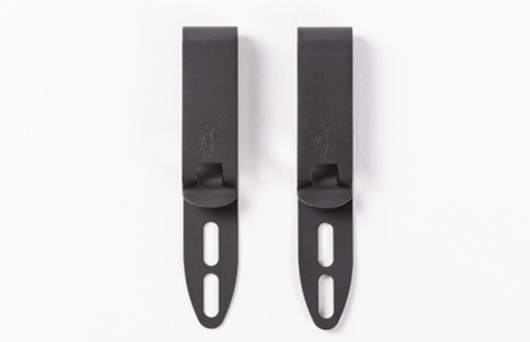
Discreet Holster Clips
If you opt for an IWB holster for carrying under a tucked-in business shirt, you’ll want to ensure there are as few hints that you are armed as possible. When worn properly and correctly concealed, the holster clip is the only holster element that remains visible, as it is attached to your gun belt.
For this reason, a high-durability, low-profile metal clip such as the HLR Discreet Clip can help you improve your setup. HLR clips are thin, low-profile, and made of steel with a non-reflective finish. They are small and challenging to spot, boosting concealability even in businesswear.
Holster Modwing
If you have decided appendix carry is the way to go, you may have noticed that your gun and holster tend to sag slightly forward, pushing the grip into your shirt and printing. The best solution to combat this phenomenon is to modify your holster with a modwing.
A modwing is a plastic tab designed to press into the inside of your pants’ waistline. It creates leverage, keeping your handgun upright and preventing it from printing under your formal shirt. There are two variants: one for standard holsters and another for light-bearing models accommodating pistols equipped with tactical lights.
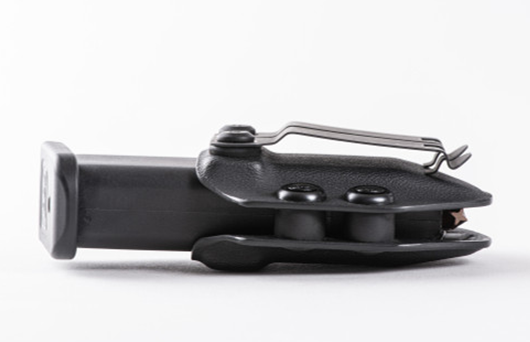
Magazine Carriers
Carrying a concealed firearm under business clothing often means making compromises regarding your choice of handgun. While smaller, slimmer, and lighter models may be easier to hide under a formal shirt or a business blazer, it comes at the cost of magazine capacity.
With these handguns, carrying only a loaded magazine plus one round in the chamber leaves you with very little ammunition. It also leaves you no way to address a magazine malfunction. The easiest solution to be more prepared is to carry extra magazines in dedicated carriers.
Like holsters, magazine carriers come in either IWB or OWB variants and are compatible with various magazine sizes, makes, and models.
Shop Discreet Concealed Carry Equipment at Incognito Concealment
Incognito Concealment produces a wide array of concealment holsters designed to fit any lifestyle, wardrobe, or handgun. Are you looking for quality, low-profile holsters for your subcompact pistol? Browse our selection of IWB holsters suited for maximum concealment and find a model that fits your gun.
Disclaimer: The information provided in this article is intended for informational and educational purposes only. It is not a substitute for professional training, legal advice, or adherence to local, state, and federal laws concerning firearm ownership and concealed carry permits.
Before making any decisions regarding concealed carry, it is crucial to consult with qualified professionals and to fully understand your responsibilities and the laws that govern concealed carry in your jurisdiction.





